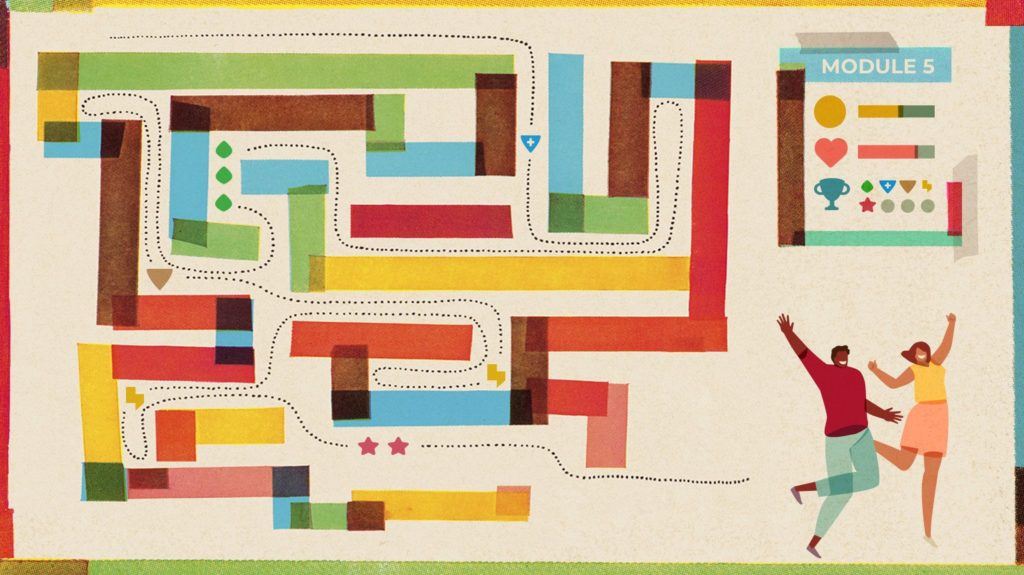Moving Beyond Gamification To eLearning
I’m Eric Avery, a veteran game designer with over a decade of experience. When I joined SweetRush last year, I knew very little about eLearning and was a bit confused by its relationship with “gamification in corporate training,” a term that seemed to be thrown around loosely. But SweetRush seemed serious about gaming, and I was ready to learn something new, so I jumped in.
To get perspective on how to marry my design skillset with gamified learning at SweetRush, I sat down with SweetRush Creative Director Shane Donahue to explore his thoughts. What follows is a conversation about gamification and learning. And how, through this conversation, we came to realize there was something even bigger and better!
A Conversation About Gamification And Learning
Eric: Let’s start with a bit about you, your background, and how you came to SweetRush.
Shane: Like you, I came from a game background, but I was a creative director and not a game designer. I always loved games, and I found myself working on games at two start-ups, and then Nickelodeon and LeapFrog, where I worked on learning games for kids. Then I joined SweetRush eight years ago, and I've seen the inclusion of gaming elements increasingly become just part of what we do in just about every project.
Eric: I’m curious to get your thoughts about this: I get the sense that “gamification in corporate training” has become a bit of a buzzword that gets thrown around but doesn’t necessarily have meaning attached to it. Am I crazy?
Shane: Well, not crazy, but I can readily understand your confusion, coming from your background, and I’ve worked with a lot of clients who are also confused. Over these past eight years, I’ve worked on pretty in-depth stand-alone games that we’ve created for clients. All are geared to teaching something, but they have to be challenging and entertaining at the same time, which is why we’re bringing on more and more game designers like you. Of course, it's difficult to create a serious stand-alone game with eLearning-type budgets, but we’ve done it many times, and I’m really proud of what we’ve pulled off. But that's not what I’d call gamification. Gamification in eLearning is simply the addition of gaming elements to eLearning courses. Now I’m talking about perhaps adding a leaderboard or earning badges and points, adding competitive elements—sometimes with a time component. And really I’d extend this to complex branching scenarios and simulations where you have to make choices. These things are just what we do all the time, just part of the language of eLearning at this point, and they really are what we call “gamification.” That's it. Pretty simple, really.
Eric: OK, I get it. What is your feeling about how well these elements are integrated into the eLearning courses? Is it true that there’s this idea of gathering your course material and learning objectives, jumping into the production process, and then, somewhere toward the end, adding points or badges or leaderboards to make it feel more engaging?
Shane: I think you’re right. That happens a lot, but obviously, that’s not how it should be done. That’s the nonorganic and shoehorned approach to eLearning gamification. It ultimately doesn’t add the true engagement we’re seeking, and it's not going to really enhance the learning experience. And, honestly, these days learners are sophisticated and know it’s BS.
Eric: So how do you do it right?
Shane: To make gamification for corporate training work, it needs to inform how to develop eLearning; it’s not a spice you just sprinkle at the end. If you consider gamification as an element that’s within and part of the solution design, the final product will be engaging, feel organic, and be a more appealing learning experience overall, which translates into not boring. And unfortunately, most eLearning is indeed boring.
Eric: OK, you’ve been on this curve at SweetRush for eight years. Where are things going? Have games inspired the way you think about eLearning?
The eLearning Experience Matrix
Shane: I’ve found myself increasingly riveted by experiences that I wouldn’t call games but that bring heightened levels of engagement such as reading a well-crafted interactive graphic novel. And now I’m going to revert to something we all know, which is adding a story to learning. A good story combined with gaming elements is the not-so-secret formula for a successful end product. And you might say this clear focus has been my recent aha moment, though I feel silly saying it as it's so obvious but just so true. I play games, but I’m seeing more and more that in the context of learning and not just mindless entertainment, you need the combination of story and gaming elements, and all of these need to be woven together fluidly, which is again why we’re bringing on more and more folks like you. This is what I’d like to call the eLearning experience matrix.
Eric: Well, I like that a lot…the eLearning experience matrix. It's interesting that you’ve been a creative director for a long time, worked on serious games and games for both pure entertainment and for learning, and now landed on this gamification married with story, all designed to not only engage but teach. This is the stuff I was hoping to get to with this interview.
Shane: Yes, thanks. This is fun, and it’s helping me crystallize my thoughts as well. I think my lens and the SweetRush lens are always evolving—let's hope so. We’ve been champions of gaming and eLearning gamification, and we’ve been embracing story, especially 3D- animation-driven and avatar-driven stories for a long time, and now these things just weave together. It's all about the experience, and if we can entertain, teach, and change behavior, we’ve done our job right.
Eric: So by going on your personal and professional journey and deconstructing gaming—and with experiences like the interactive graphic novel—you’ve effectively expanded your toolbox for eLearning. You see the ways that information is communicated, stories are told, and various mechanics operate to create an experience...drum roll...the eLearning experience matrix.
Shane: I think before it was more about the mechanics: “Here’s an interesting element. Let's plug it in.” But things have matured, and I now see story as the soul that holds it together.
Eric: So maybe the bottom line is that eLearning should feel like or be an experience, just like a well-crafted book or movie or game. But it's all ultimately geared to achieve certain learning objectives and change behavior.
Shane: Yeah, you really nailed it. And I can see you’re leaning into the instructional language that every creative at SweetRush has to embrace. Welcome to the world of Learning and Development! I think that like me, you’ll get excited about L&D because it's using your gaming skills to actually affect people's lives by improving their capabilities.
Eric: Let me ask you a different question: Do you think everyone in eLearning should be playing games?
Shane: Let's put it this way, everyone needs to be curious, and our audiences are increasingly digital natives for whom interactivity and gaming are just the way things are. Ten years ago, the Instructional Designers were over there and we were over here, both doing our things somewhat separately, and that no longer works. We need to work collaboratively. So designers need to think and understand Instructional Design, and IDs need to fully embrace all levels of interactivity in the way they think. So, does everyone need to be a gamer to pull off good gamified learning? No, because you can get creative interactive ideas from many life experiences. But I would say that both the creative designers and the IDs need to embrace story, as that is what holds it all together. But let me contradict myself somewhat and say that now that I really think about this, I suspect that in the near future everyone in eLearning will need to be gaming literate—it's just too important to the medium.
Eric: What about clients? I guess we can't forget them. What are their expectations?
Shane: I’m seeing that more and more clients want learning that’s memorable because their learners are demanding more authentic and enjoyable ways to learn. This is pretty much what we’ve been talking about, this eLearning experience matrix thing. We recently created a 10-hour eLearning program that we and the client are calling “binge-worthy” because it's actually fun and engaging, with deep character development and storyline, but all the time teaching important lessons about how to be a newly minted manager. For sure there are gaming elements, but that’s only one part of the overall matrix. This is what savvy clients are now demanding. It's awesome for designers because it's a lot more creative and fun to design these solutions. If a learner is bored with an eLearning product, you can be sure the developers were bored creating it.

Eric: This is getting interesting. If the products are less basic and more organic and embrace all the elements in the matrix that go beyond basic eLearning, how are you communicating these concepts to the clients?
Shane: And that’s a great question. We have a team of solution architects and learning designers who are pretty darn good at reaching out to all of us to collaborate on solutions and ideas and then pull them all together into a concept. Not all clients are comfortable with new ideas, but some are, and some are more inclined to innovate and get creative. We do the spectrum, and new ideas today are just everyday tomorrow, like gamification for corporate training, which was so new and cutting edge but now is just a regular part of what we do. That is just the evolution. Of course, we’re also doing things like Virtual Reality, which again embraces all the elements in the matrix—storytelling and interactivity—but in a fully immersive environment. So the beat goes on, and it keeps us engaged and excited about the future.
Eric: Let's wrap up with this question. Is there something you might call the through line?
Shane: Well, again, talking all this out has been helpful for me as well, so thank you for the conversation and the questions. I’d have to land on story, and inherent in story is emotion. And then I think that what we’ve discovered through this back-and-forth is that all the elements come together into this eLearning matrix experience, with the key word being “experience.” If a learner has an experience that is authentic and engaging and that keeps their attention, all the while imparting valuable information and changing their behavior, we’ve done our job well.

Eric: Thanks, Shane. This has been enormously helpful for me. I get the eLearning gamification thing now, and I love that we've gone way beyond to the realm of the whole experience—the eLearning experience matrix thing. I see how being a game designer in the context of learning means I can share a lot and lend value, and I also get to add a lot to my skillset. I now see that while entertainment and engagement have to always be there, I need to think about what the player, I guess you’d say “the learner,” is actually learning and how I’ve helped to change their performance. I already have ideas, and I’m inspired to help take SweetRush to the next level. Let's do this again!
Shane: For sure!









